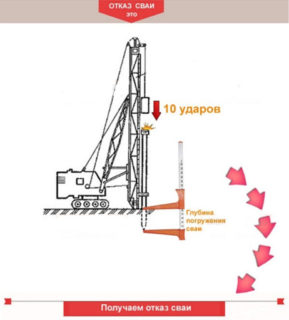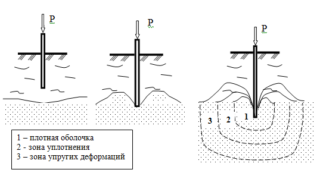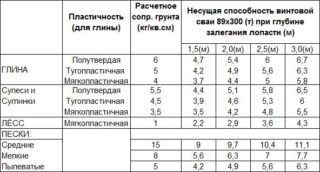Pile foundations are attractive for their use on different types of soils, including heaving, swampy and other problem soils. When arranging the base, it is important to correctly carry out preliminary calculations. One of the important parameters is pile failure.
Definition and necessity of collateral
The calculated failure of a pile is an indicator that indicates its sufficient depth, as well as the ability to withstand the load assumed by the construction project.
Several types of tests are recommended for maximum calculation accuracy. This includes dynamic and static testing of support elements as well as soil studies and sounding procedures.
True and False Pile Failure
False is obtained immediately after the end of the dive to the point at which its depth from the bail is identical to the project plan. A true failure occurs after a certain period of time after the static load has been removed, and the earth has time to restore its structure. The method of determining this value by means of blows of a special hammer designed for driving piles is called dynamic tests. The duration of the break varies depending on the soil conditions inherent in the area.
The curing time is influenced by the composition of the soil, its moisture content and density. In the Moscow region, it can vary within 20-40 days. After the soil is restored, the bearing capacity of the support element increases compared to what it was immediately after the pile was inserted into the ground.
Gersevanov's formula for calculating pile failure
L = ((F * Er * n) / (P (Kn * P + F * n) * Kn) * (e (q1 + q) + Qn) / (q1 + q + Qn)).
The values included in the expression:
- F - cross-sectional area of the support in square meters;
- Er - impact energy;
- n - coefficient used when driving reinforced concrete piles using a diesel hammer;
- P - the design value of the bearing capacity;
- Kn - coefficient of reliability;
- q - the mass of the support with the head element;
- q1 - the mass of the grandma;
- Qn - the weight of the diesel hammer;
- e - coefficient showing the restoration of support after impact.
The calculation results in the refusal value in centimeters. The mass values used in the formula, as well as the bearing capacity, are expressed in kilonewtons (1 kN = 102 kg). Parameter q1 used in the case of the location of the installation for driving the supports above the pit. Coefficient e for a reinforced concrete structure equipped with a headrest and a wood insert, it is 0.2. Parameter n taken equal to 150 kN / m2.
The reliability factor depends on the number of piles: the more there are, the lower the number. For 1-5 datums, the value will be 1.75. If there are more than two dozen piles, take the figure 1.1.
Calculation of the bearing capacity of the pile
P = (yc / yq) * (0.5 * F * n + √0.25 * F2 * n2 + (F * n / e) * QH * ̅ ((Q + 0.2q) / (Q + q)))
The value e in this formula is the actual value of the failure, QH Is the work of the hammer, and Q Is the mass of its striking segment. Coefficients used in expression yc and yq indicate, respectively, the operating condition of the support and the reliability. The rest of the variables represent the same values as in the previous formula.
Average value for piling
The average for piling is called failure. It can be defined in different ways, depending on the way the support is immersed in the ground and the tool used. The following quantities are distinguished:
- Indentation failure determined by the force at the final 0.5 m of penetration. This section is divided into 5 segments of 0.1 m and a parameter is fixed for each of them.
- Driving failure - the average value of the support deepening with a single movement included in the top ten final in the pledge.
- Parameter used when working with a vibrating immersion tool. It is determined by the last third of the deposit, lasting 3 minutes.
If the value of the support has exceeded the calculated one, it continues to be deepened after a certain period of its passive stay in the soil. The duration of this interval depends on the composition and characteristics of the soil. It is least of all in coarse sandy soils that are not distinguished by high humidity: in this case, the pile is left to overexpose for at least three days. The maximum spacing is set when the support passes through soft clayey soil that is soft or fluid.
Practical application of the obtained data
If, when the structure is submerged to the required depth, the failure value remains too high even after the manipulations made after the holding period are completed, the work is coordinated with the company that prepared the project. Its representatives can advise you to make changes to it or conduct static testing of the supports. There are cases when the failure parameter is set strictly, and the degree of penetration is given a lower value. Then it is allowed to undercut the support (but not more than 0.5 m).












